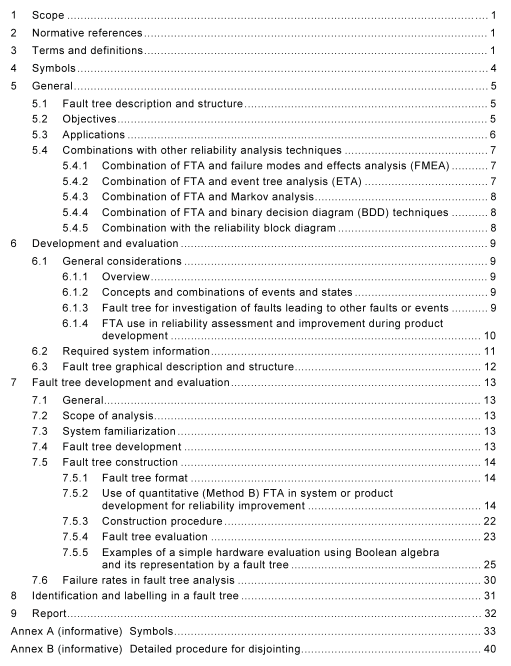AS IEC 61025 pdf – Fault tree analysis (FTA)

AS IEC 61025 pdf – Fault tree analysis (FTA)
5 General 5.1 Fault tree description and structure Several analytical methods of dependability analysis are available, of which fault tree analysis (FTA) is one. The purpose of each method and their individual or combined applicability in evaluating the flow of events or states that would be the cause of an outcome, or reliability and availability of a given system or component should be examined by the analyst before starting FTA. Consideration should be given to the advantages and disadvantages of each method and their respective products, data required to perform the analysis, complexity of analysis and other factors identified in this standard. A fault tree is an organized graphical representation of the conditions or other factors causing or contributing to the occurrence of a defined outcome, referred to as the “top event”. When the outcome is a success, then the fault tree becomes a success tree, where the input events are those that contribute to the top success event. The representation of a fault tree is in a form that can be clearly understood, analysed and, as necessary, rearranged to facilitate the identification of:
– factors affecting the investigated top event as it is carried out in most of the traditional fault tree analyses; – factors affecting the reliability and performance characteristics of the system, when the FTA technique is used for reliability analysis, for example design deficiencies, environmental or operational stresses, component failure modes, operator mistakes, software faults;
– events affecting more than one functional component, which could cancel the benefits of specific redundancies or affect two or more parts of a product that may otherwise seem operationally unrelated or independent (common cause events). Fault tree analysis is a deductive (top-down) method of analysis aimed at pinpointing the causes or combinations of causes that can lead to the defined top event. The analysis can be qualitative or quantitative, depending on the scope of the analyses. A fault tree can be developed as its complement, the success tree analysis, (STA), where the top event is a success, and its inputs are contributor to the success (desired) event. In cases where the probability of occurrence of the primary events cannot be estimated, a qualitative FTA may be used to investigate causes of potential unfavourable outcomes with individual primary events marked with descriptive likelihood of occurrence such as: “highly probable”, “very probable” “medium probability”, “remote probability”, etc.
The primary goal of the qualitative FTA is to identify the minimal cut set in order to determine the ways in which the basic or primary events influence the top event. A quantitative FTA can be used when the probabilities of primary events are known. Probabilities of occurrence of all intermediate events and the top event (outcome) can then be calculated in accordance with the model. Also, the quantitative FTA is very useful in reliability analysis of a product or a system in its development.
FTA can be used for analysis of systems with complex interactions between sub-systems including software/hardware interactions.
5.2 Objectives FTA may be undertaken independently of, or in conjunction with, other reliability analyses. Objectives include:
– identification of the causes or combinations of causes leading to the top event;
– determination of whether a particular system reliability measure meets a stated requirement;
5.3 Applications FTA is particularly suited to the analysis of systems comprising several functionally related or dependent subsystems. Benefits of FTA are apparent when a system design is the product of several independent specialized technical design groups and the separate fault trees are linked together. Fault tree analysis is commonly applied when designing nuclear power generating stations, transportation systems, communication systems, chemical and other industrial processes, railway systems, home entertainment systems, medical systems, computer systems, etc. Fault tree analysis is also of particular value when applied to systems comprising various component types and their interaction (mechanical, electronic and software components), which cannot be easily modelled with other techniques. An example of this would be a combination of events where their order of appearance is essential such as existence of vibration fatigue causing fracture cracks and failures of components.









